It is at least 54 million kilometres from home. For the rest of its life, the advanced ground-penetrating radar Rimfax will be examining Earth’s red neighbour.
What is hidden beneath the surface of the fourth biggest planet in our solar system? FFI’s and Norway’s first device on Mars landed in February 2021.
Rimfax is installed underneath an American six-wheeler. Perseverance is NASA’s newest vehicle. It is mapping Earth’s neighbour more thoroughly than its predecessor Curiosity. The rover is searching for water and looking for signs of previous life on the planet. It is in full swing collecting and sealing rock samples to be returned to Earth on a subsequent expedition.
Rimfax is an important part of the expedition – and a success story for FFI.
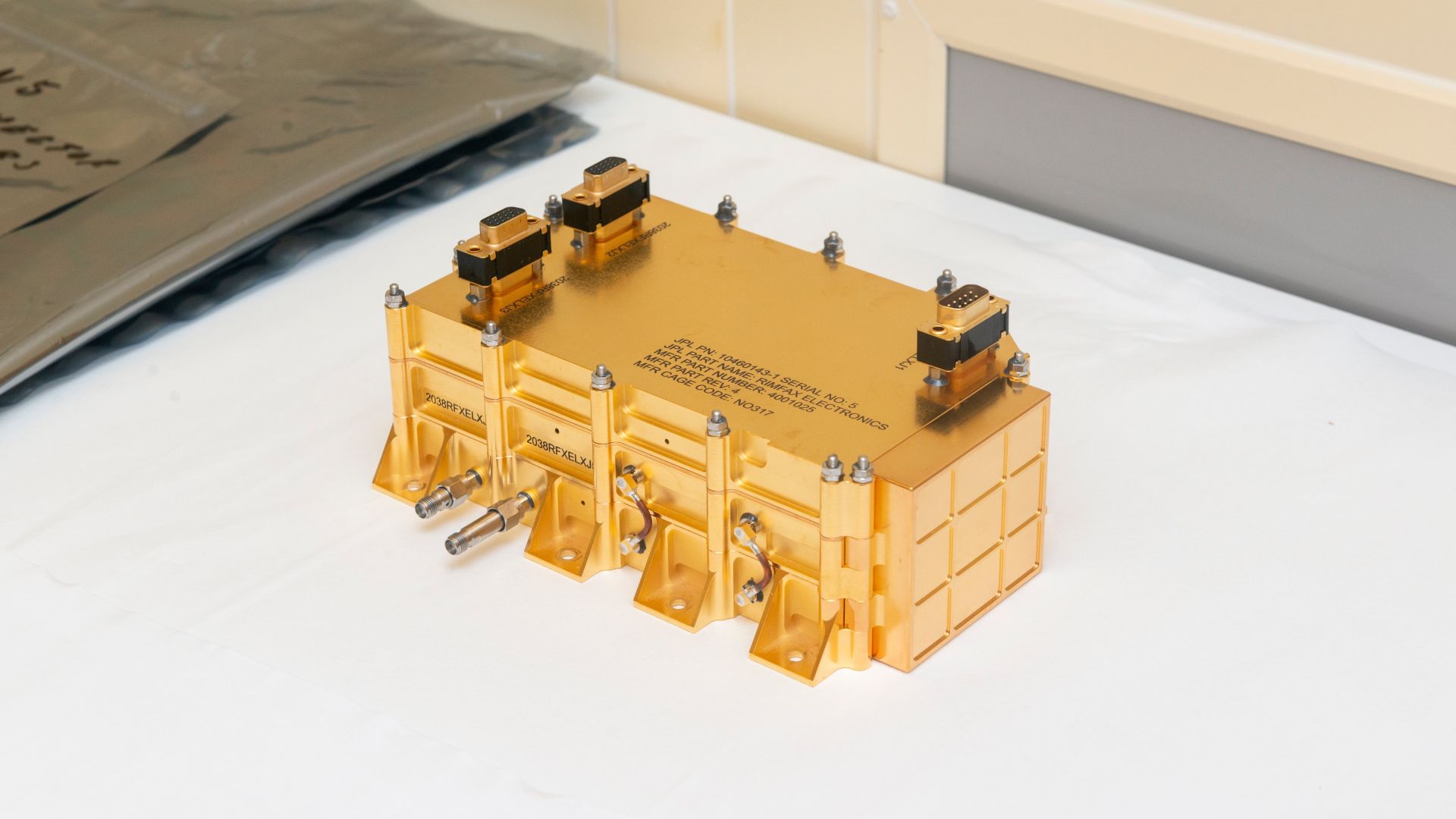
The ground-penetrating radar FFI has created for NASA consists of two main components. This gold-plated box is one of them. It houses Rimfax’s electronic components and is located inside the body of the vehicle.

The other part is a specially designed antenna made of aluminium. Here is the antenna of a previous version. Now it is painted white and hangs on the outside of the rear of the vehicle.
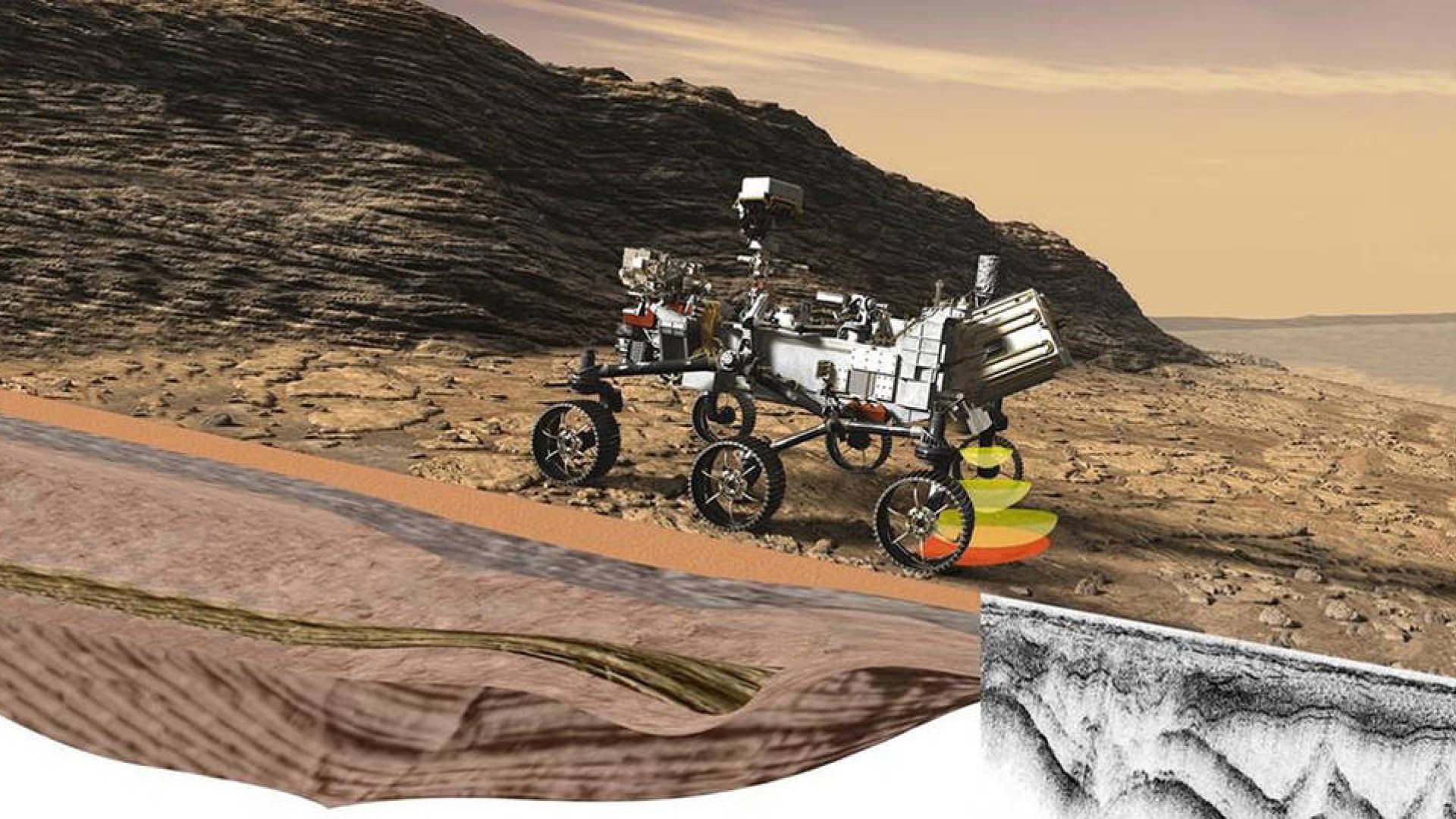
Rimfax uses radar technology to take pictures of the geology of Mars.
Humans are going to Mars
NASA does not hold back in its description of this expedition. It states that it wants to study the habitability of the planet and that it is preparing future crewed missions.
One of the instruments will check if it is possible to produced oxygen from carbon dioxide (CO2). This will be easier than transporting oxygen from Earth. The atmosphere of Mars currently consists of 95 per cent CO2.
Oxygen is not only necessary for potential human missions to Mars. The greatest need at present relates to the launching of spacecraft from the surface of the planet. There is insufficient gas for take-off: Mars barely has an atmosphere. On the Earth’s surface we have a pressure of 100,000 Pascal (Pa, the unit of pressure). The corresponding figure on Mars is 600 Pa.
An equally important question concerns liquid water. Does it exist? Perhaps Rimfax can help find the answer.
FFI saw the opportunity
How did a Norwegian research institute become involved in this?
Initially, it was not a given that a ground-penetrating radar would be part of this NASA expedition. However, the U.S. space agency decided it wanted one.
The brief story of Rimfax is that the FFI researchers saw the opportunity. This happened when NASA announced a competition in 2013. This is something NASA frequently does: They signalled their needs to communities worldwide.
A Perseverance instrument that was to look beneath the surface was something to which FFI could contribute, as the institute had already been involved in developing such a radar. The starting point was a ground-penetrating radar that was developed in the late ‘80s and used to study glaciers on Svalbard. It was later further developed at the University of Oslo. This prototype was then further developed by FFI. It was natural take part in NASA’s competition. The Americans said: “Yes please, we want it!”.
FFI has developed different types of radars for the Norwegian Armed Forces, e.g., a through-the-wall radar and radars for mine detection. Similar technology is used in archaeology and to research avalanches. FFI has also studied the use of this type of ultra-wideband radars for medical purposes, e.g. to study the heart. However, Rimfax is something else.
The answer to why NASA preferred FFI’s solution has not been made public.
“NASA simply announces which one has been selected”, explains Professor Svein-Erik Hamran.
He was the initiator of the Rimfax Project and has managed it from the beginning. As Principal Investigator and member of the Project Science Group (PSG), he has headed both the instrument development and the scientific use of the data.
“We know that we received good marks for our proposals and generally scored high on all the points that were evaluated. At least two other radar proposals were submitted. Of the 58 submitted proposals for instruments, NASA selected seven.”
Tested on glaciers and in desert landscapes
Mars is a cold and dry planet. The thin atmosphere can result in temperatures down to –140 degrees Celsius. On a summer day on Mars, the temperature can reach a comfortable 20 degrees Celsius. All technology on the planet has to be able to withstand these fluctuations.

The enormous temperature fluctuations have entailed strict requirements for the testing of the radar. Many tests have taken place in laboratories and by using simulations. However, it has also been important to conduct tests in environments that are as similar as possible to where it will be used.
“Svalbard is a good analogue of Mars, since it is cold and dry there. There, we determined that the instrument functions in cold conditions and that Rimfax can see through snow, ice and the ground itself below the glaciers”, explains Hamran.
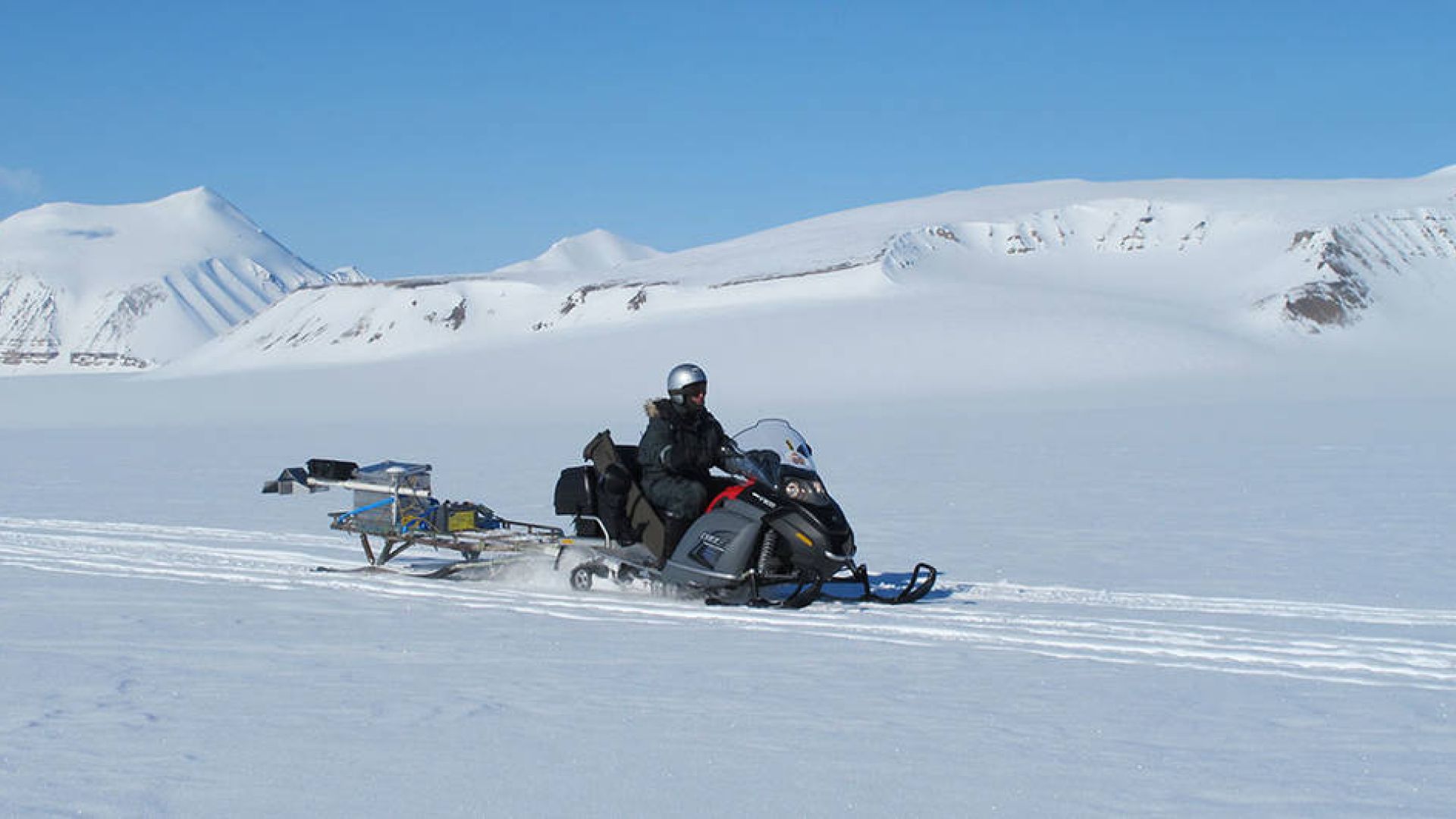
With the radar firmly attached on a snowmobile sled, the researchers drove on glaciers outside the research station of Ny-Ålesund.
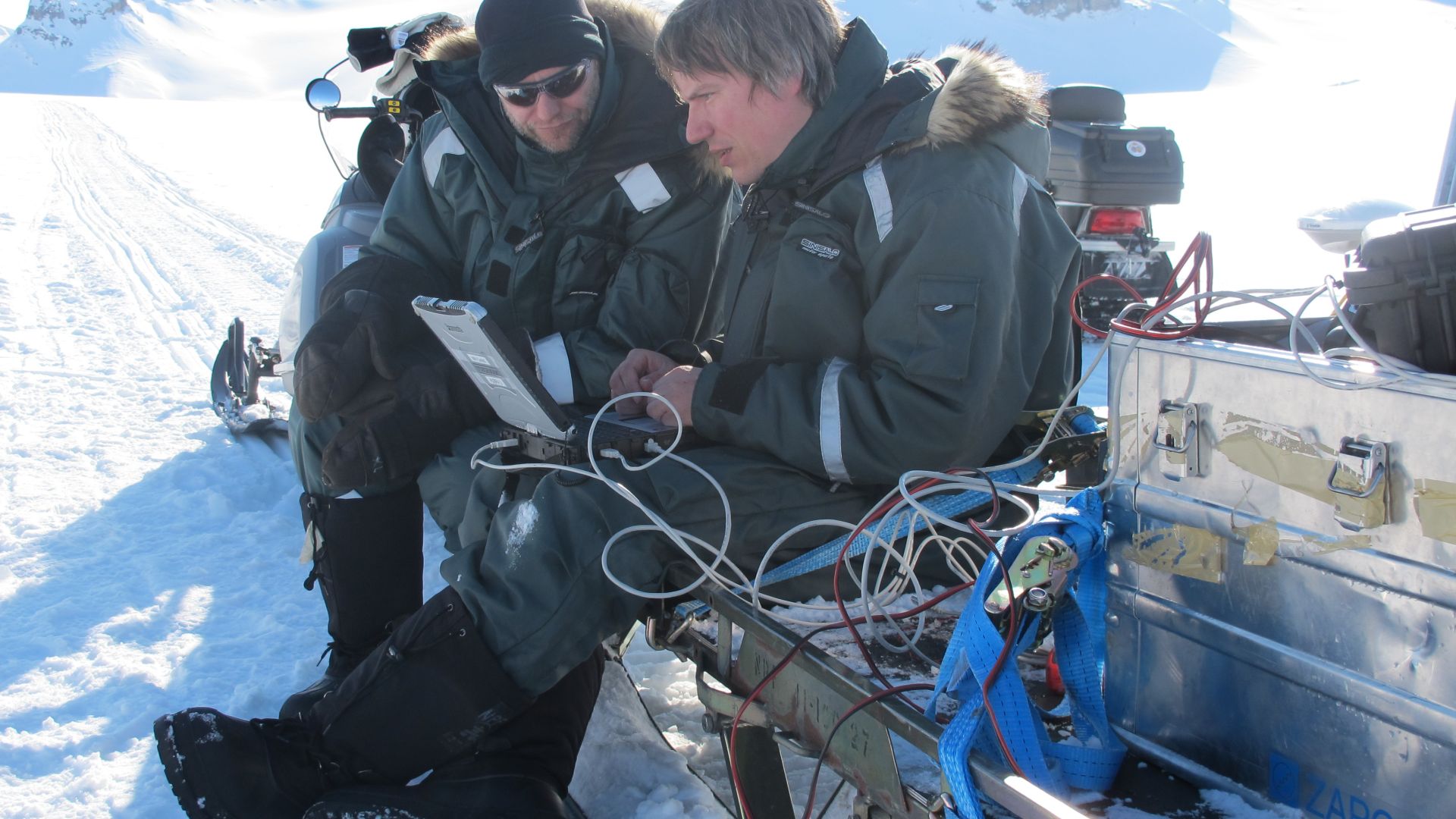
In regular intervals, they would stop, check how the radar had functioned and make adjustments to the settings. Under fairly cold but beautiful working conditions.
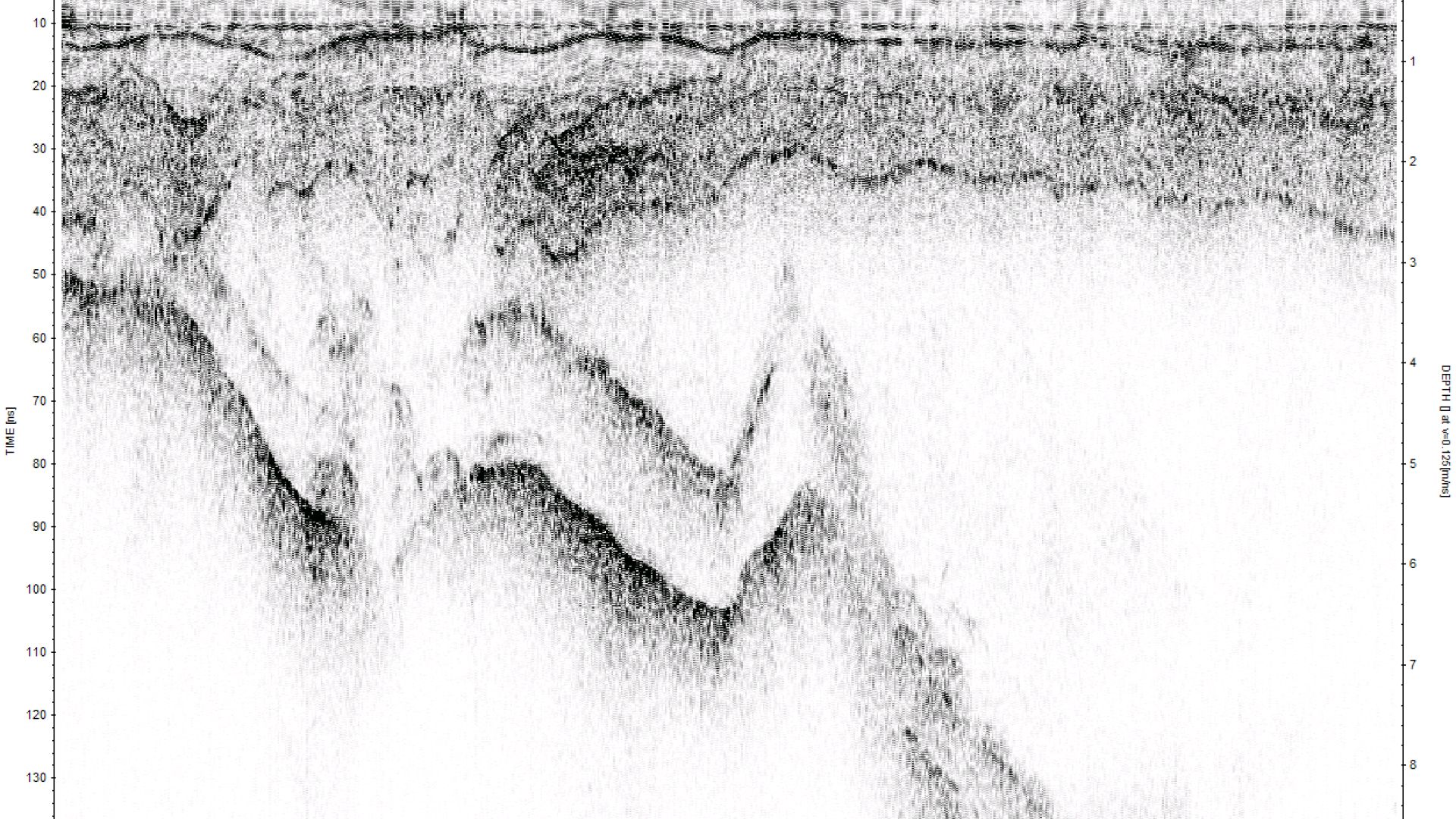
While the researchers were driving across the glacier, Rimfax mapped what was hiding beneath the snow. In radar images like this, trained eyes can read how thick the glacier is and the structure thereof.
Desert landscapes are also suitable for testing, since there is little water in the ground. Thus, the course was set for Utah, USA. Here, the snowmobile was replaced with a four-wheeler.
Fantasy planet
What kinds of instruments are actually needed to explore an unknown planet?
Mars has captured the human imagination for thousands of years. This has also been the case for researchers, based on an anecdote from a book on how the Viking space probes were developed.
The FFI researchers are unsure of whether the story has any basis in reality, but it is good, nevertheless: When NASA was going to send the first space probes to Mars in 1976, the researchers did not know much about the Red Planet. One of the proposals for scientific instruments at the time was actually a robot arm with a food bowl and a camera in the background. This would enable them to film the creatures that came over to feed!
Not many new Mars observations were needed to determine that the Viking space probe’s landing component was a few billion years too late for this. Completely different tools than food bowls are needed to get to know the planet.
A continuous NASA success
NASA’s Jet Propulsion Laboratory can point to a continuous success with its Mars spacecraft. The 11-kilo Pathfinder began the work in 1996. The twin rovers Spirit and Opportunity weighed more than 180 kilos when they landed in 2003.
Curiosity weighed more than 900 kilos when it landed in 2012. Perseverance is as big as a small SUV and weighs 1025 kilos.

In-house competence
There are strict requirements for something that is to function on a different planet, explains head researcher Leif Damsgård of FFI. He is one of the five researchers who have comprised the core team for Rimfax. He emphasises that they would never have completed the development had it not be for the significant contributions of these Norwegian enterprises.
“The development could not have been completed without this support. Thanks to the efforts of all our partners, the instrument could be developed and manufactured in its entirety in Norway”.
Tor Berger is one of the key researchers in the Rimfax team. He is now heading the actual operation of Rimfax on Mars. FFI’s own workshops and laboratories have been crucial in accomplishing this, he explains:
“FFI has broad in-house competence which we could draw upon and work closely with. I believe it would have been more difficult if we had to leave the premises with everything we had to do. It was a huge advantage that many of us could walk across the hall and plan and implement environmental tests without getting our shoes wet. Some of the tests required us to go outdoors to implement. Even though it went well in the end, it was more of a hassle to implement them.
The name Rimfax has two meanings: The name is an acronym for Radar Imager for Mars' Subsurface Experiment. At the same time, the word is a play on Norse mythology: Rimfakse is the horse on which the night rides across the sky. The name can be translated as ‘frost from the muzzle’. Morning dew is what drips from Rimfakse’s bit.

What is a ground-penetrating radar?
RIMFAX is what is known as a Ground Penetrating Radar (GPR). GPR technology is often used on our own planet in order to study layers of soil and ice and to locate groundwater. Rimfax generates images of the layers of the ground on Mars, several metres beneath the surface. This is done by sending electromagnetic radio waves straight down. The radar then reads the reflected signals.
Ideally, the radar’s ‘ear’ should be to the ground. Such a solution could not be utilised with Rimfax. NASA’s requirements would not allow this as the risk was too great. What if a drag antenna got tangled? There would be no one on Mars to lift it up and send the rover on its way. The radar had to function at a distance from the ground which, in turn, made the design more challenging.

In the very most sacred room in NASA’s Jet Propulsion Lab (JPL), work is being done on the Mars 2020 Rover.

The room is known as High Bay. It is much bigger that it appears in the picture. The ceiling height is more than 10 metres. Pictured, from the right, are Christina Hernandez from JPL and Sverre Brovoll and Leif Damsgård from FFI.

The Rimfax antenna is installed on Perseverance by experienced JPL engineers. They are the only ones who are allowed to handle the equipment here.
Duplicates are necessary
The Apollo 13 mission in 1970 was the expedition that almost went completely wrong. Everyone is familiar with the line from the crew: “Houston, we have a problem”.
In the motion picture about the events, we see that those on the ground had inventory completely identical to that found in the space capsule, all the way down to the astronauts’ personal belongings.
The point is that, in this messy heap of objects, they found what the needed to safely guide the spacecraft back down. Moral: An exact duplicate of something you do not get an overview of in any other way can be invaluable.
This is also the case with the Rimfax devices. There exist three identical devices. One is on board the rover. The other is in Pasadena. The third is at Kjeller. In the event of problems requiring a physical inspection, the possibility is there.
During the development of Rimfax, both the requirements and follow up were at an extremely detailed level.
“We needed to have complete control of the instrument at all times. Strict quality requirements entailed, among other things, that it could not pass through an X-ray machine when we were to travel from Norway to the United States.
Therefore, we had to carry the Rimfax original by hand. People from NASA followed us throughout the trip. Entire delegations; there was a review team from JPL’s instrument group that followed up the development here”, explains Leif Damsgård.
“More than twenty people also travelled over here on several occasions, to follow the development”.
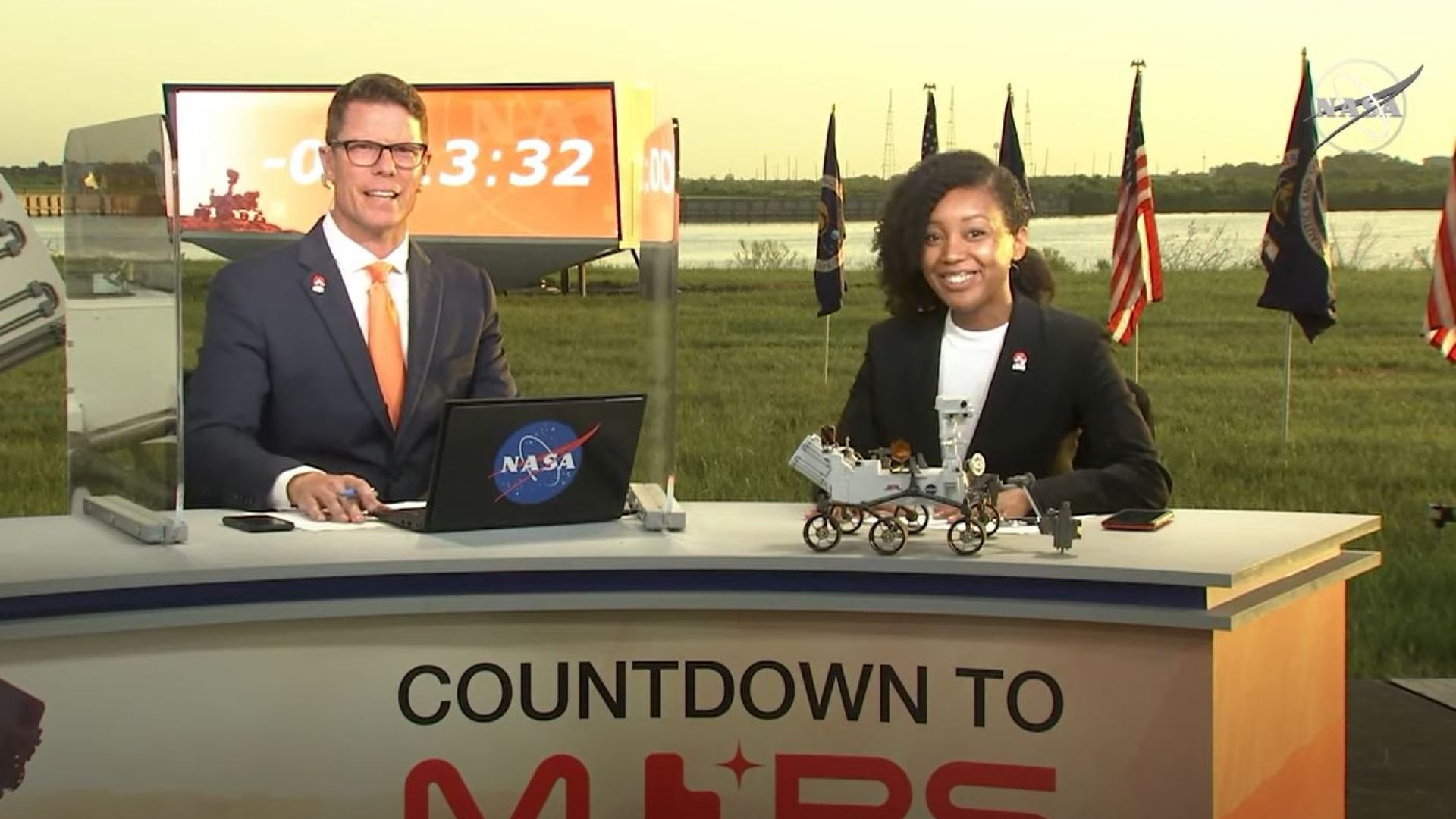
30 July 2020. Cape Canaveral, Florida. It is only a few minutes to launch. Thousands are following the broadcast, both in the U.S. and in the rest of the world.
The window for the launch was 21 days, in July and August 2020. If the launch had to be delayed, it would be 26 months until the next time Mars and the Earth would be in a position relative to each other to allow for another attempt.

The destination for the mission is the Jezero Crater on Mars, which may have been a river delta.
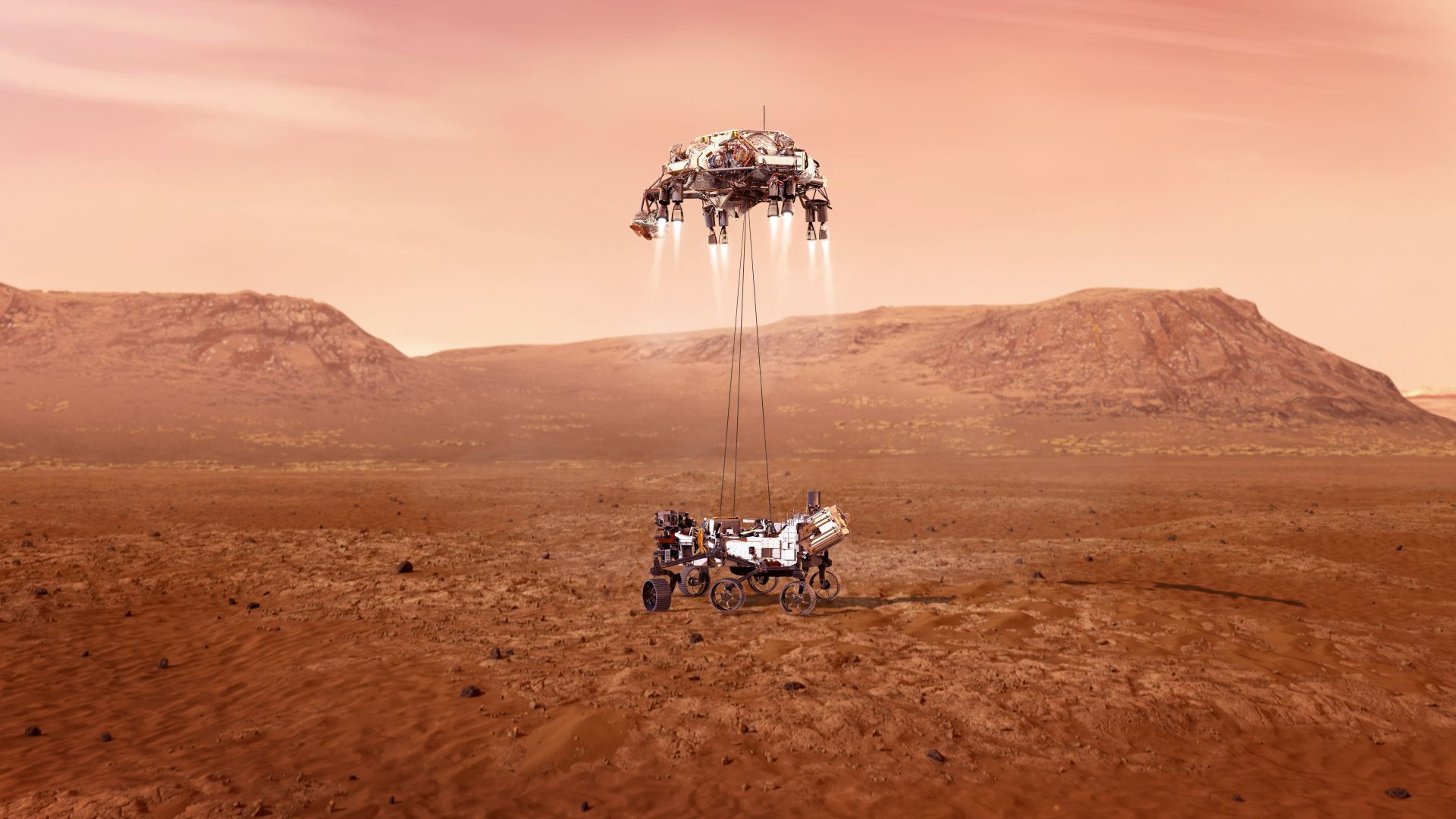
The greatest excitement was associated with the landing operation itself. At that point, nothing could be controlled from Earth.
NASA has stated that the mission will last at least one Mars year, i.e., 687 Earth days. The rover and the instruments on board are expected to be able to function much longer.
Seven minutes of terror
Mars is very far away. The rover landed on 18 February 2021, following a journey that began in the summer of 2020. The landing was spectacular, nerve-racking and – for those following from the journey – only possible to follow with an 11-minute delay. This was the time it took for the signals from Mars to reach the Earth.
Seven of these minutes were especially exciting.
The audience back home on Mother Earth had been told of “the seven minutes of terror”. The seven minutes during which even the most experienced NASA engineers had to close their eyes and cross their fingers. It could have ended in disaster.
In this animated film from NASA, you can see how the landing operation proceeded:
“It is about the time it takes for the spacecraft to complete the landing sequence without being able to do anything from Earth. This period is referred to as Entry, Descent and Landing (EDL). This means the time from the rover enters Mars’ atmosphere and until it lands on the surface. There is contact throughout but nothing can be done from Earth to remedy a possible situation”, explains Svein-Erik Hamran.
Once the seven minutes of uncertainty had passed, everyone in the control centre were cheering. The landing was faultless. Over the course of a few days, the rover was ready for an expedition that, in the worst case only lasts for the 687 days in a Mars year, or in the best case, more than ten Earth years.
A pocket of saltwater
What do the researchers hope to find?
The most sensational outcome would be the discovery of water. It cannot be ruled out that there are residual traces of what might have been a water-rich part of Mars’ history. There might have been rivers here 3–4 billion years ago. There might have been oceans. The landing area is near the Jezero Crater. This location was selected because it resembles a dried-out river delta. Jezero means lake in many Slavic languages.
Perhaps there is a place down in the sediments that contains salt water that has not yet evaporated. Rimfax can see as deep as 20 metres subsurface. There may be something there. Whenever the rover is driving, Rimfax is scouting everything beneath it, as far as the radar signals can reach.
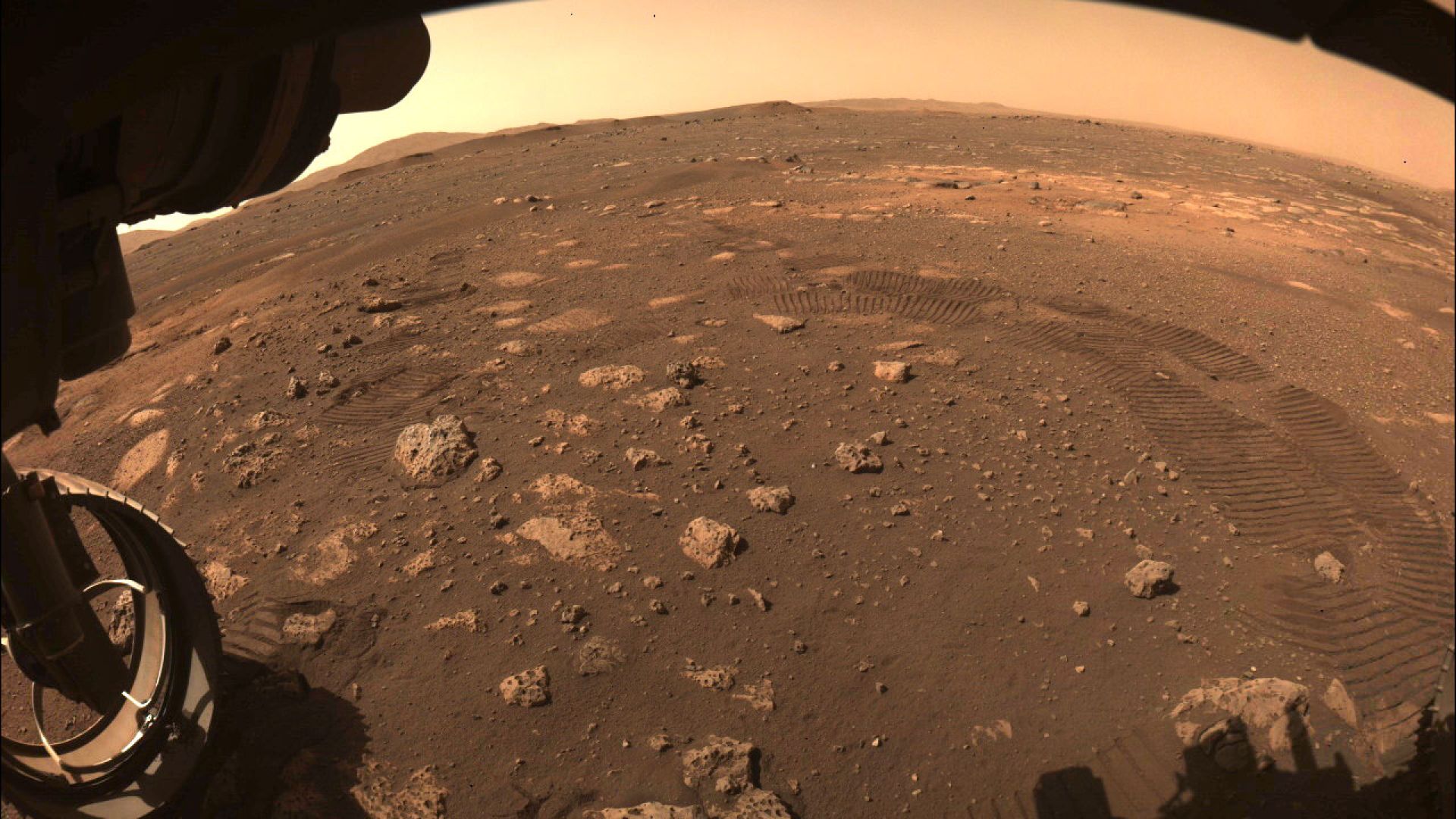
This is what is looks like on Mars. This is one of the images the Mars rover itself took shortly after the landing.
The time lapse film does not give an accurate impression. In reality, the rover is moving slowly. It is hardly race car. Perseverance means continued effort despite difficulties. Nevertheless, gigabyte by gigabyte of information returns to the researchers on Earth.

Svein Erik Hamran (left) was the originator of Rimfax, while Tor Berger is now heading the actual operation of the ground-penetrating radar on Mars.
From the control room at Kjeller, the researchers are excitedly following Rimfax’s deliveries. Both FFI and UiO have been closely involved in the Mars expedition. Going forward, it is UiO that will be controlling the radar operations.
Bowie’s question
“The bestselling show: Is there life on Mars?” sings David Bowie. For the researchers, the question is formulated incorrectly; It should be: “Was there life on Mars?”.
“A problem with finding water on Mars is that the atmosphere is too thin and the atmospheric pressure is too low. What now exist in terms of ice above or beneath the surface sublimates. That means it transitions to a gas and disappears into space. There is no water on the surface. Thus, the conditions for life are currently poor”, says Hamran.
What exactly happened to Mars?
Our solar system is 4.5 billion years old. Life on Earth first occurred one billion years later. Researchers believe Mars might have undergone the same development. However, the solar winds were detrimental, explains Svein Erik Hamran:
“Charged particles and plasma thrust from the Sun are referred to as solar winds. Earth has a magnetic field that protects us. Mars does not. Any atmosphere that might have existed has been blown away, slowly but surely. The same applies to water and possibilities for life as we know it.
Musk and China
The first man on Mars, who will it be? The idea is no longer science fiction. On the contrary, it is a stated goal of NASA, with an indication that it may happen already in 2030.
Several states and major companies have joined the race to achieve this. Neither China nor Elon Must necessarily believe that the U.S. will win this time. Musk has his spectacular Starship and SpaceX concepts. Earlier this year, the Chinese declared that they are preparing a crewed Mars mission in 2033. Perhaps the Americans will be delayed?
In any case, NASA will share its Mars data as they are retrieved and interpreted.
Over the course of this century, it is quite possible that a version of Matt Damon’s astronaut in Ridley Scott’s motion picture The Martian (2015) will become a reality.
We are still at the beginning of a story that may one day end in a human being setting foot on another planet for the first time. Everything depends on what the researchers are able to wring from Mars in terms of knowledge and secrets.
Rimfax is one of the pioneers.










